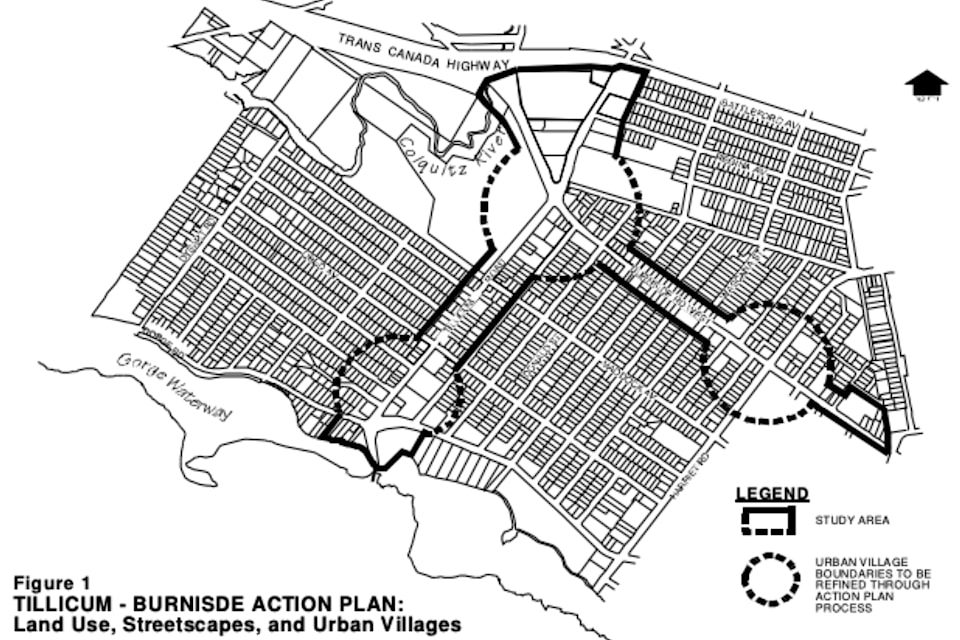In 2005, Saanich released the Tillicum Burnside Action Plan.
The document recognized that “Tillicum and Burnside roads do not meet their full potential as vibrant community corridors” and that “more intensive work was needed to address land use and streetscape issues.”

The 38-page document called for mixed land uses – housing, retail, employment, and institutions – along the corridors to boost affordable housing and transit, while greening streets and expanding open space.
Nearly 20 years later, the Gorge Tillicum Community Association (GTCA), which helped shape the plan, says little has been achieved.
With zoning bylaws misaligned with the proposed plan, along with unrealistic timelines and budgets, the association says next to nothing came out of the 2005 plan beyond two apartment towers and minor street improvements.
With another plan underway that echoes similar goals and aspirations, the GTCA fears history will repeat itself with the Tillicum Burnside Plan (TBP), which has been in the works since December 2024.
In a letter to Saanich council and planning staff, association president Vera Wynn-Williams and vice-president Phil Lancaster urged the district to reconsider the plan, warning that the process could fall short again after completing its phase of public consultation.

“The primary purpose of the letter was to alert Saanich across the board… that there are things in the planning process that make no sense to us at all,” said Lancaster. “We're still stuck with the same problem of trying to get them to recognize that their process itself is flawed.”
After attending all engagement sessions, Wynn-Williams and Lancaster remain skeptical, calling the process “needlessly complicated and expensive,” and warning it could lead to “unmet expectations and community backlash.”
“There was so much confusion at the sessions themselves,” said Wynn-Williams. “(Council) is going to come up with a draft 10 months from now that, once again, people are gonna be like, ‘That's not what I said'.”
“The whole point of this process is to prevent public outcry by coming up with something that represents something like a consensus,” Lancaster added. “But it completely failed, both at a technical and political level.
“The engagement was terrible, the communications about the process were absolute crap, and here we are looking at what, to me, is still a bit of a secretive process because they won't share with us the results of any of their discussions with developers or business owners.”
The community advocates argued the workshops failed to capture community needs or clarify basics such as plan boundaries, which they warn will “affect people’s entire life savings in a property.” They also shared that consultants appeared unfamiliar with the area, even misidentifying the Saanich-Victoria boundary.
“They hire consultants, (who) are usually Vancouver-based, and they don't really know the community that well,” said Wynn-Williams. “It very much felt like a boilerplate consultation process.”

For 20 years, Lancaster and Wynn-Williams have pushed for development in the area, but say the plan must be rooted in achievable goals, not aspirational “blue-sky thinking.”
“None of the technical rubber-hits-the-road issues were really discussed at all,” said Wynn-Williams.
Having dealt with Saanich for years on various files, the two argue the municipality’s approach to development is flawed, putting developers in charge of community growth when, in their view, the municipality should set the pace.
If development is driven project by project, Wynn-Williams and Lancaster argued, the result is piecemeal upgrades, rather than the fully connected, complete streets as promised in the plan.
“They're telling us about complete streets, yet what we're going to have is a patchwork of sidewalks down Tillicum and… the street is never going to get done,” said Wynn-Williams.
“If you actually want a complete street, then the city has to lead with some of that investment and then recoup the money from the developers as they come and from the tax base (that grew) by densifying your community,” added Lancaster.
The pair is calling on the city to create a plan anchored in realistic timelines and adequate budgetary goals.
“Development is going to come and we'd like it to be in certain areas, but that needs to be laid out so that people can make good decisions,” Wynn-Williams said. “(Otherwise) what is the value of a process that generates a plan that cannot be implemented?”
Saanich’s response
“The point is well taken,” said Saanich Mayor Dean Murdock, acknowledging the shortcomings of the 2005 plan and concerns from the GTCA, noting it no longer “accurately reflects a lot of the changes in the official community plan and provincial changes.”
“The community association has put their finger on exactly the challenge that there is often a pretty considerable gap between the expectations developed in a plan that becomes dated,” he said. “That's why it's so important that this process updates that vision to better reflect the reality of both the current market conditions and building code requirements.”
Adding that the district has “learned a lot” in terms of its planning processes, Murdock stressed the need for an updated plan to guide development in the area over the next two decades.
“The (2005) action plan clearly set out some expectations that weren't met, but I think it also spelled out conditions which were not based on the reality of construction costs and infrastructure replacement,” he said. “An up-to-date vision will allow for a clear signal that here is an area that's eager for transformation and investment in terms of housing, amenities and commercial services.”
And while Murdock mentioned Saanich can set conditions to encourage private investment in housing and commercial projects, he noted the “sluggish construction market,” rising interest rates and investor uncertainty remain significant barriers for development in the area.
“There's a real eagerness to get going (but) there's limitations on the right-of-way that Saanich has versus the frontage that would come with a private development,” he said.
The mayor also acknowledged that change has not unfolded as heralded in the 2005 plan, but said the municipality has undertaken significant projects in recent years, including replacing subsurface infrastructure and improving pedestrian and cycling networks, which he noted “are not small investments.”
While projects of this magnitude are bound to face their fair share of criticism, Murdock said the municipality showed due diligence by hosting various public input sessions and workshops to gather the community’s perspective.
Saanich Planning said in a written statement that the TBP will focus on land use designations and transportation strategies, with “clear policies and an implementation strategy to make future actions feasible.”
While the plan is still in development, Saanich Planning added that residents will still have a chance to chime in before the publication draft plan expected in early 2026.
“We absolutely need the community and stakeholders to get involved and provide input into this new plan,” reads their statement. “If we want a community that works for everyone, we need to hear from everyone.”
Awaiting to see what the municipality has in mind, Wynn-Williams and Lancaster concluded that strong leadership and concrete action are needed to regain association's trust.
“We’ve heard 20 years of promises with almost nothing to show for it,” she said. “Another 20 or 30 years of ‘aspirations’ isn’t good enough. The community needs a real, funded, time-stamped action plan now,” said Wynn-Williams. “Without concrete progress and policy alignment, this plan will be just another glossy document collecting dust.”






